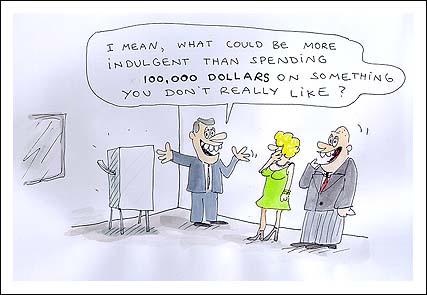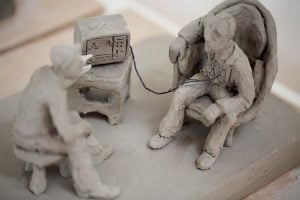In Conversation | Olav Westphalen
Olav Westphalen is a long-established cartoonist and German artist. Together with the Project Arts Centre’s new curator Livia Páldi, he has created The Museum of Modern Comedy (MoMCo) – A Proposal. It is either an artwork in the guise of a speculative museum or a museum dressed up as a contemporary installation. In conversation with Visual Arts editor Sinead Phelan, he discusses the concepts and initiations of creating MoMCo, who it is for and what is its purpose.
You walk into the gallery and there’s a wall with a logo for the Museum of Modern Comedy in Art. While coming in on top of the wall there’s a potted plant,, making a kind of semi-corporate entrance. Then inside, there’s two different modalities; either the video programme is on, or not. If it’s not on then you come into a room that is dominated by a large chart – which is a heavily researched and fairly accurate chart of incidents and developments in avant-garde art. These are usually talked about as really important moments of masculine boundary trespassing, and which I think can much more accurately be described as jokes, as fairly unsuccessful jokes. Then the other element in the room are seven clay figurines that show some of these situations. For example, Malevich painting the Black Square in 1915. We know now, because it was x-rayed in the winter of 2015, that underneath it has both other paintings but also a caption from a cartoon from 1887 by a French humorist. So in a way the Black Square, the biggest icon of modern art, is directly related to a fairly silly satirical print from thirty years earlier. The museum display is to offer an alternative reading of what we see as something avant-garde and serious.
[perfectpullquote align=”full” cite=”” link=”” color=”#8BD616″ class=”” size=””]Marxism was based on the idea that, with Enlightenment, reality changes because we know what’s wrong. What we know by know is: we know what’s wrong and we’re perfectly fine with it.[/perfectpullquote]
I think it’s more serious if they’re jokes because it’s much more aggressive. The narrative of art would be that art is this alternative business of being important, making sense. I think it’s much more aggressive to think of the interesting moments as moments where people refused to do that. They refused to extrapolate logically or think reasonably or even seriously. So, I’m not saying that ‘here’s the avant-garde and really it was a series of jokes’ but ‘here’s the avant-garde and it’s old and boring and linked up with modernism and ideas of masculinity, rationality, European domination; and here’s the avant-garde actually as a gesture, as a series of radically irresponsible funny or silly childish gestures.
There is a text by Paulo Virno which is kind of the starting point of this whole thing- it’s called Jokes and Their Relation to Innovative Action. Virno, being an old militant leftist thinker, at one point writing a book about jokes – that’s interesting. Someone who really comes from the side of wanting to change society says ‘it’s not working like this’. This idea, that once people know what is wrong with the world they will want to make it right – it doesn’t work. Marxism was based on the idea that, with Enlightenment, reality changes because we know what’s wrong. What we know by know is: we know what’s wrong and we’re perfectly fine with it.
Virno says the one moment when reality really transforms is when people suddenly laugh; one second ago it was true, a second later it’s ridiculous. That kind of violent transformation is the engine of any joke. He argues it could also be the engine of social change, something has to happen where reality gets questioned; It’s a linguistic operation. It’s not about mobilisation, it’s about changing – the king without the clothes for example. The mechanisms that happen when people suddenly reframe reality in a radical way.

I’ve been making cartoons with a friend of mine for 30 years, and when we started nobody wanted to print our stuff. The first review when we put our first book out was ‘as if drawn by five year olds for stupid people’. So it wasn’t like we were embraced very much and it took a long time to become a grandfather of a certain tradition of cartoons in Germany. So I think I’ve always thought about that both as a fine artist and as a cartoonist; I’m always interested in the things that don’t really fit neatly but fit just enough to be allowed in the door.
You do minimise your customer-base by poking fun at them. But there is some who enjoy it – so I get smart collectors that have the ability of self-deprecation. The cartoons I never sell; the cartoons are for publication and that’s it. But the other works I do- they are of course meant to be thought of as artworks but at the same time… as an artist I just really really lose patience. I’m also egotistical. But you only live once – YOLO. So if I wasted all this time on something because I think somebody else might like it, then I could just get a job- you know, I think being a carpenter would be fun. You make this practical thing – that would be super fun.
[perfectpullquote align=”full” cite=”” link=”” color=”#8BD616″ class=”” size=””]Right now, art is saddled with all these tasks that I don’t think it will be able to live up to. Changing the world, helping people in the suburbs, solving the immigrant crisis. I think people are starting to be quite disappointed.[/perfectpullquote]
This is of course on some level about understanding things, negotiating how you are in the world, how you relate to reality, to art, to culture. If it doesn’t serve that then I think it’s better to just walk away and do something else. It’s not about not wanting to please people but more about wanting to be interested – and we end up with things. With the art world of course, and this has happened to me a number of times in my… [laughs] relatively little/long career, that something really flew off the self, and it was like, make more. But then they’re fabricated. Now we know what it is, so why would I?
There’s trade-offs in everything. I mean this [exhibition] is maybe commercially a slightly less viable road. But I don’t have problems teaching for example and making money in other places so I can do what I find interesting…. Not only do I think that it’s not a contradiction to have this in a gallery, I think it’s necessary; where else would it make sense? You have to kind of say, ‘this is here because it belongs here’. This is a conversation about the art world. Also of course, it’s a piece, it’s a narrative piece; from the potted plant to the logo…
For a long time when i was doing more informative work/performative work, I realised that whenever I did something good, that I was actually happy with it a year later, it would be something that embarrassed me mortally inside. If you’re not really embarrassed to do it, don’t do it. Because if you’re not really embarrassed to do it, you’re just doing a job. The ridicule would be perfectly welcome. Because I think that there’s the art world, the world of artists and art makers and people who actually get it and they are interested in these things. They want to understand how does art work, what can it do. Right now, art is saddled with all these tasks that I don’t think it will be able to live up to. Changing the world, helping people in the suburbs, solving the immigrant crisis. I think people are starting to be quite disappointed. Its an interesting moment to think how does it actually work; what are we good at? And I don’t think we’re so good at doing politics, we’re really bad at it. Anybody who is really interested in activism or political change dismisses the art world really fast. Any real philosophers, they don’t come to the art world. Philosophers who want to take a breather, come to the art world and hang out a little bit. If you apply for a show or for a project or public art they’ll say what is it good for? Will it raise the literacy rate? Will it help children in the suburbs? All those things are really important, but art is a really poor tool to do that – it is much better to hire three social workers on a decent salary to work there for five years – they can probably do miracles. Bring in an artists to do a temporary installation, it’s kind of art-washing. So, I think there is this moment when the people who are serious about art reality check: what can we actually do?
[perfectpullquote align=”full” cite=”” link=”” color=”#8BD616″ class=”” size=””]There is a tiny percentage of the populis that have cash problems- not the kind of cash problems that you or I have. If you look at them as a class, you realise I am producing status items for that class[/perfectpullquote]
Then there is that art world which is about investment, like in any other market. Until the bubble bursts, if enough people say it’s worth it, it’s worth it. It will be worth it until it’s not anymore. But those are completely different. Those are not even art criteria anymore. There is a business side that is completely detached from these kind of conversations. They don’t wanna know, they don’t have to know. If it’s shiny and 8 Russians bought it, you’re gonna make your money back. [laughs] It’s true!

We have an economy right now where there is so much cash concentrated among a very very small amount of people, globally speaking. Basically I think they don’t know what to do with it; they’ve also gone through a couple of crashes and right now art seems to be a pretty safe place – also let’s not forget good for money laundering. There is a very direct relationship between art and real-estate, art and money laundering, art and drug money. All these things are missed but well documented. If you look at Mark Lombardi for example, he made these amazing graphs – in a way related a little bit to this, he was one of the people we thought of when we made the big chart in the show – he made these large maps of connections between artists, collectors, political figures and so on. There is a tiny percentage of the populous that have cash problems – not the kind of cash problems that you or I have. If you look at them as a class, you realise I am producing status items for that class.
If you go back even to Benjamin Buchloh or even further back to Greenberg and Harold Rosenberg, people were having serious serious intellectual debates about art, about how much pictorial space there was on a painting, and that was important and that mattered. And because that was powerful everybody else – collectors, museums – there was a balance of power. He had collectors, but they wouldn’t just buy what they liked. They would understand that they needed to learn, be educated. Museums cannot buy anything collectors don’t want to give to them; critics don’t have space and that they have space that’s important – in a way it’s like artists, you are also talking to a small interested community. You are no longer a three-quarter page in the New York Times telling collectors, “Come buy this shit!”
The exhibition runs in The Project Arts Centre 39 East Essex St, Temple Bar D2 until this Saturday 21st Oct from 11.00am-7.30pm. Admission is free.
